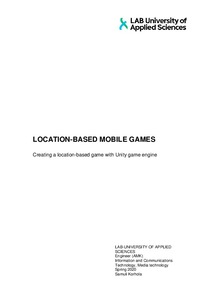Analyzing Virtual Reality Gaming Through Theoretical Frameworks
Faragó, Zsombor (2024)
Faragó, Zsombor
2024
Julkaisun pysyvä osoite on
https://urn.fi/URN:NBN:fi:amk-202501131259
https://urn.fi/URN:NBN:fi:amk-202501131259
Tiivistelmä
Virtual reality (VR) gaming has become a revolutionary platform, providing immersive and interactive experiences, that change the meaning of traditional gaming. This study investigates the theoretical frameworks that provide the foundation for the design and player experiences in VR gaming, focusing on two notable case studies, Beat Saber and VRChat. The research utilizes Presence Theory, Flow Theory, the Technology
Acceptance Model (TAM), Social Presence, and the Proteus Effect to analyze how these games implement theoretical principles to create engaging and impactful experiences.
The research was conducted using a qualitative, case-study methodology. A comprehensive literature review established a theoretical base, followed by gameplay analysis, user feedback exploration, and secondary data collection for each case study. Beat Saber showcases the use of spatial presence, flow, and embodiment to create rhythmic, skill-based gameplay. In contrast, VRChat emphasizes social presence, usergenerated content, and avatar embodiment to encourage creativity and community building.
Findings reveal that while both games benefit from using VR’s unique capabilities, their approaches appeal to different player motivations. The study highlights the importance of theoretical principles in VR games design and identifies opportunities for future projects and research, including the integration of new and emerging technologies and applications in different areas other than gaming, such as education or therapy.
Acceptance Model (TAM), Social Presence, and the Proteus Effect to analyze how these games implement theoretical principles to create engaging and impactful experiences.
The research was conducted using a qualitative, case-study methodology. A comprehensive literature review established a theoretical base, followed by gameplay analysis, user feedback exploration, and secondary data collection for each case study. Beat Saber showcases the use of spatial presence, flow, and embodiment to create rhythmic, skill-based gameplay. In contrast, VRChat emphasizes social presence, usergenerated content, and avatar embodiment to encourage creativity and community building.
Findings reveal that while both games benefit from using VR’s unique capabilities, their approaches appeal to different player motivations. The study highlights the importance of theoretical principles in VR games design and identifies opportunities for future projects and research, including the integration of new and emerging technologies and applications in different areas other than gaming, such as education or therapy.
Kokoelmat
Samankaltainen aineisto
Näytetään aineisto, joilla on samankaltaisia nimekkeitä, tekijöitä tai asiasanoja.
-
Game Development in Unity : Game Production, Game Mechanics and the Effects of Gaming
Dansie, Jason (Metropolia Ammattikorkeakoulu, 2013)The goal of this thesis is to examine how video games are designed and to see how differ-ent game mechanics work and how to use them in the development of a game, as well as examine what are both the positive and negative ... -
Location-based mobile games : creating a location-based game with the Unity game engine
Korhola, Samuli (2020)The subject of this thesis is location-based mobile games. Location-based mobile games are a way for mobile games to combine reality with virtual worlds and thus re-define the gaming experience. This thesis presents ... -
”WE WANT A 3D GAME” : Customer expectations for the games company when buying a serious game
Sorppanen, Mikko (Oulun seudun ammattikorkeakoulu, 2012)All digital games are not used for entertainment. Some of them can also be used for non-entertainment purposes and these games are called serious games. This thesis is carried out in co-operation with one Finnish games ...



